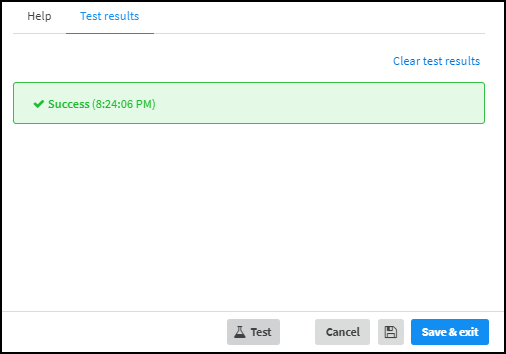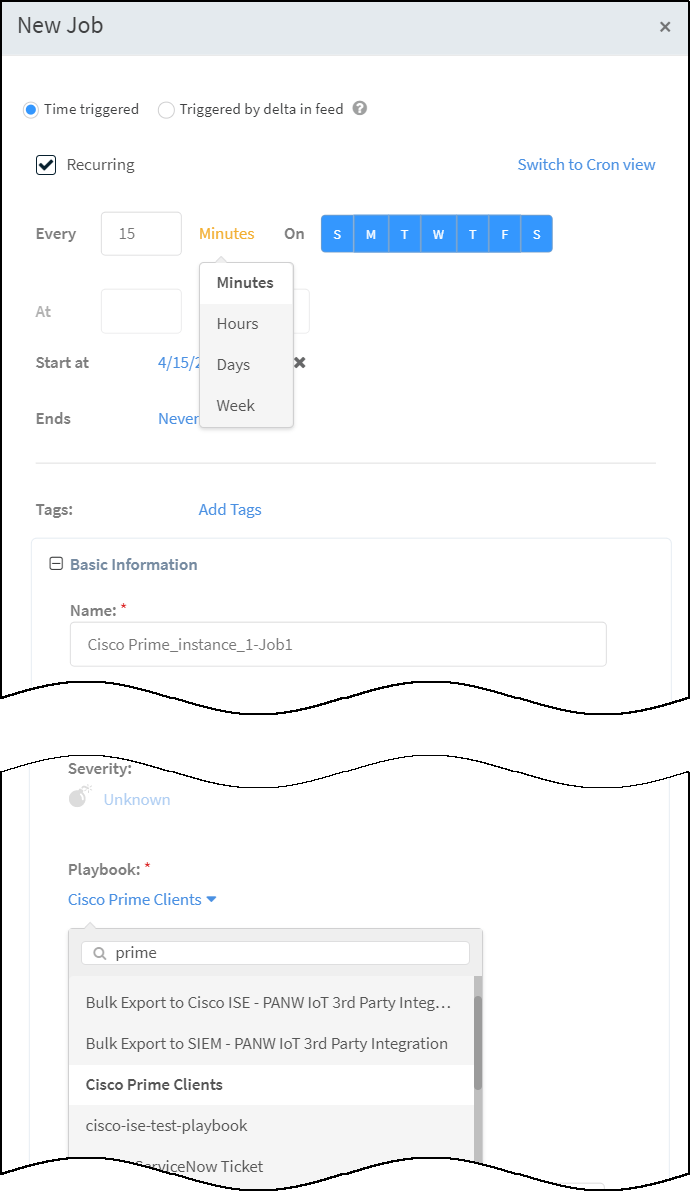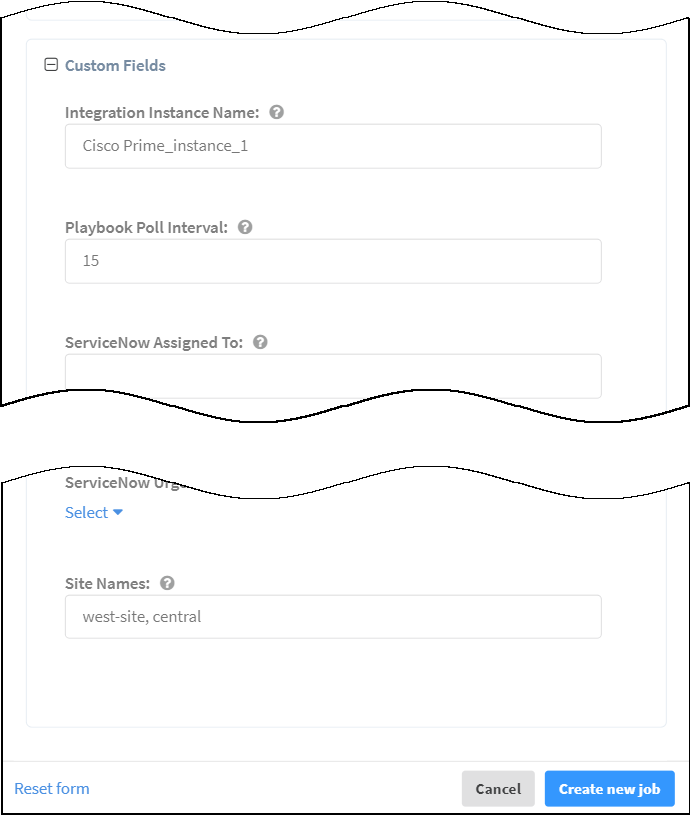IoT Security
Set up IoT Security and XSOAR for Cisco Prime Integration
Table of Contents
Expand All
|
Collapse All
IoT Security Docs
Set up IoT Security and XSOAR for Cisco Prime Integration
Set up IoT Security and Cortex XSOAR to integrate with
Cisco Prime Infrastructure.
| Where Can I Use This? | What Do I Need? |
|---|---|
|
One of the following Cortex XSOAR setups:
|
To set up IoT Security to integrate through
Cortex XSOAR with Cisco Prime Infrastructure, you must add a Cortex XSOAR engine to your network.
You must also configure the
Cisco Prime integration instance in XSOAR. To do this, you need
the IP address of your Cisco Prime system and the username and password
of the NBI read-only user account that the XSOAR engine will use
when forming a secure connection with Prime.
Cortex XSOAR Engine Installation
The Cortex XSOAR engine initiates connections
to Cisco Prime Infrastructure and to the Cortex cloud and provides
the means through which they communicate with each other. Although
it's possible to install an XSOAR engine on machines running Windows,
macOS, and Linux operating systems, only an engine on a Linux machine
supports IoT Security integrations. For more information about operating
system and hardware requirements, see the Cortex XSOAR.
We recommend downloading the Cortex XSOAR engine using the shell
installer script and installing it on a Linux machine. This simplifies the
deployment by automatically installing all required dependencies and also
enables remote engine upgrades.
When
placing the XSOAR engine on your network, make sure it can form
HTTPS connections to your Cisco Prime system on TCP port 443. The
XSOAR engine uses TCP 443 when authenticating with Cisco Prime and
requesting and receiving device data.
The on-premises firewall must allow the Cortex XSOAR engine to form
HTTPS connections on TCP port 443 to the Cortex cloud at
https://<your-domain>.iot.demisto.live/. You can see the URL of your Cortex XSOAR instance when you log in to the IoT Security portal
and click Integrations and then click Launch
Cortex XSOAR. It’s visible in the address bar
of the web page displaying the Cortex XSOAR interface.
To create an Cortex XSOAR engine, access the Cortex XSOAR
interface (from the IoT Security portal, click
Integrations and then click Launch
Cortex XSOAR). In the Cortex XSOAR UI,
click SettingsEngines+ Create New Engine. Choose
Shell as the type.
For Cortex XSOAR engine installation instructions, see Engine Installation.
For help troubleshooting Cortex XSOAR engines, including installations,
upgrades, connectivity, and permissions, see Troubleshoot Engines and Troubleshoot Integrations Running on
Engines.
Configure IoT Security and Cortex XSOAR
- Log in to IoT Security and from there access Cisco Prime settings in Cortex XSOAR.
- Log in to IoT Security and then click Integrations.
![]()
- IoT Security uses Cortex XSOAR to integrate with Cisco Prime, and the settings you must configure to integrate with Prime are in the XSOAR interface. To access these settings, click Launch Cortex XSOAR.The Cortex XSOAR interface opens in a new browser window.
- Click Settings in the left navigation menu, search for cisco prime to locate it among other instances.
![]()
Configure the Cisco Prime instance.- Click Add instance to open the settings panel.
- Enter the following and leave other settings at their default values:Name: Use the default name of the instance (Cisco Prime_instance_1) or enter a new one.Remember the instance name because you are going to use it again when creating jobs that Cortex XSOAR will run.Cisco Prime Server URL: Enter the Cisco Prime Server URL.Cisco Prime username: Enter the name of the NBI read-only user account you previously created in Cisco Prime.Password: Enter the password associated with the user account.Run on Single engine: Choose the XSOAR engine that you want to communicate with the Cisco Prime system.
![]()
- When finished, click Run test or Test.If the test is successful, a Success message appears. If not, check that the settings were entered correctly and then test the configuration again.
![]()
- After the test succeeds, click Save & exit to save your changes and close the settings panel.
To enable Cisco Prime Integration Instance, click Enable.Create a job for XSOAR to get a list of MAC addresses of active devices from IoT Security and then query Cisco Prime for details about the devices in the list.IoT Security and XSOAR only request details from Prime if a device has a MAC address. If your network has static IP devices without MAC addresses, they will not be included.Copy the name of the instance you just created, navigate to Jobs, and then click New Job at the top of the page.In the New Job panel that appears, enter the following and leave the other settings at their default values:Recurring: Select this because you want to periodically poll Cisco Prime for device details.Every: Enter a number and set the interval value (Minutes, Hours, Days, or Weeks) and select the days on which to run the job. This determines how often XSOAR sends a list of MAC addresses of currently active devices from IoT Security to Cisco Prime and receives device details in response.As a general rule of thumb, this job takes about 15 minutes per 1000 devices to complete. Other factors that might affect the time required to complete a job are the Cisco DNA Center API processing speed and settings.Name: Enter a name for the job.Playbook: Choose Cisco Prime Clients.![]() Integration Instance Name: Paste the instance name you copied a few moments ago.Playbook Poll Interval: Enter a number (the value, though unspecified, is minutes) defining the period of time during which IoT Security must see device activity to include it in the list of currently active devices it provides to XSOAR. It’s common to use the same interval as the one above for running the recurring job.Site Names: By default, the XSOAR retrieves device data from all sites that IoT Security manages. If there are multiple sites and you want to get device data from a subset of them or Cisco Prime is managing a subset of them, specify them by name here. Separate multiple names with commas. Use quotation marks around names with spaces. Because the Cortex XSOAR UI opens in a new browser window, you can return to the previous window with the IoT Security portal and navigate to AdministrationSites and FirewallsSites to view a list of site names.
Integration Instance Name: Paste the instance name you copied a few moments ago.Playbook Poll Interval: Enter a number (the value, though unspecified, is minutes) defining the period of time during which IoT Security must see device activity to include it in the list of currently active devices it provides to XSOAR. It’s common to use the same interval as the one above for running the recurring job.Site Names: By default, the XSOAR retrieves device data from all sites that IoT Security manages. If there are multiple sites and you want to get device data from a subset of them or Cisco Prime is managing a subset of them, specify them by name here. Separate multiple names with commas. Use quotation marks around names with spaces. Because the Cortex XSOAR UI opens in a new browser window, you can return to the previous window with the IoT Security portal and navigate to AdministrationSites and FirewallsSites to view a list of site names.![]() Click Create new job.The job appears at the bottom of the Jobs list.Enable the job and run it.Check the Job Status for the job you created. If it’s Disabled, select its check box and then click Enable.After you enable it, keep the check box selected and click Run now. The Run Status changes from Idle to Running. In addition, running a job in XSOAR triggers the referenced integration instance to appear on the Integrations page in the IoT Security portal.At the defined interval, XSOAR begins the job by first requesting an active device list from IoT Security and then using that list to query Cisco Prime for client details, which it forwards to the IoT Security cloud.If you have multiple Prime instances, add more jobs as necessary.To add another, click Add instance, configure the settings as previously explained, and then click Done.
Click Create new job.The job appears at the bottom of the Jobs list.Enable the job and run it.Check the Job Status for the job you created. If it’s Disabled, select its check box and then click Enable.After you enable it, keep the check box selected and click Run now. The Run Status changes from Idle to Running. In addition, running a job in XSOAR triggers the referenced integration instance to appear on the Integrations page in the IoT Security portal.At the defined interval, XSOAR begins the job by first requesting an active device list from IoT Security and then using that list to query Cisco Prime for client details, which it forwards to the IoT Security cloud.If you have multiple Prime instances, add more jobs as necessary.To add another, click Add instance, configure the settings as previously explained, and then click Done.![]() You can configure multiple instances with different XSOAR engines retrieving device information from the same Cisco Prime server. However, a single engine cannot retrieve information from multiple servers.Run each job you create at least once to populate the Integrations page with all the integration instances you’re using in XSOAR.Return to the IoT Security portal and check the status of the Cisco Prime integration.An integration instance can be in one of the following four states, which IoT Security displays in the Status column on the Integrations page:
You can configure multiple instances with different XSOAR engines retrieving device information from the same Cisco Prime server. However, a single engine cannot retrieve information from multiple servers.Run each job you create at least once to populate the Integrations page with all the integration instances you’re using in XSOAR.Return to the IoT Security portal and check the status of the Cisco Prime integration.An integration instance can be in one of the following four states, which IoT Security displays in the Status column on the Integrations page:- Disabled means that either the integration was configured but intentionally disabled or it was never configured and a job that references it is enabled and running.
- Error means that the integration was configured and enabled but is not functioning properly, possibly due to a configuration error or network condition.
- Inactive means that the integration was configured and enabled but no job has run for at least the past 60 minutes.
- Active means that the integration was configured and enabled and is functioning properly.
When you see that the status of an integration instance is Active, its setup is complete.






